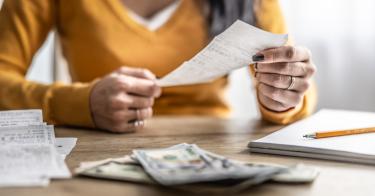If you went only by the latest headlines, you’d think the U.S. economy was in great shape.
The Bureau of Economic Analysis recently revealed that gross domestic product (GDP) grew 4.9% in the third quarter of this year. This was greeted by various media outlets as “blockbuster” growth that “defies expectations.” As Yahoo Finance titled its article: “U.S. economy grows at fastest pace in nearly two years.”
But a cursory look beyond these headlines shows a completely unsustainable economy, failed government policy, and a coming recession.
GDP has four main components: consumer spending, government spending, international trade, and investment. The last category is noteworthy because it’s the driver of economic growth. Fixed investment, which includes things like factories and machines, is lower today than in the first quarter of 2022 after adjusting for inflation.
Less investment means lower—even negative—future growth.
>>> Treasury Just Dropped a Financial Bomb, but Bidenomics Means the Worst Is Yet To Come
The only subcategory within investment that grew quickly was business inventories, which accounted for about 27% of all the economic growth in the last quarter. Faced with higher future costs amid renewed inflation fears, many firms stocked up on inventories. Because of how GDP is calculated, this shows up as faster growth today, but it means slower growth tomorrow.
That means the surge of inventories simply shifted economic growth from a future quarter or quarters to the last quarter. It’s an accounting maneuver, not a sign of sustainability. Conversely, the subcomponents of investment that aid economic growth were basically flat in this report.
Likewise, the impact of international trade was also minimal, but not so for consumer and government spending, which grew 4% and 4.6%, respectively. Consumer spending growth is usually viewed as a good thing since it’s correlated with people earning more money and higher levels of production—in other words, economic growth.
But that’s not what we see in this report.
Instead, Americans are depleting their savings and going into debt to fuel their spending. Disposable income fell again last quarter and is now down $1.6 trillion from the first quarter of 2021, after adjusting for inflation. As Newsweek put it in one of the more honest headlines: “Americans Are Burning Through Their Extra Income.”
Once consumers run out of savings and start losing access to credit, spending will necessarily drop. Additionally, families will eventually have to replenish their savings and get out of debt, which means a smaller portion of future income will be available to buy goods and services.
But debt concerns aren’t stopping government spending, which grew faster than its consumer counterpart for the fifth quarter in a row, fueled by $835 billion in borrowing at the Treasury Department—in just three months, the equivalent of a $3.3 trillion annual deficit.
All that additional government spending and borrowing accounted for almost a fifth of the total growth in Thursday’s GDP report. This is another unsustainable trend because all government spending must be paid for by the private sector, which is being crowded out by an ever-growing public sector. Once again, this points to slower economic growth in the future.
>>> The Fuse on America’s Debt Bomb Just Got Shorter
And just when you thought that was the end of the bad news, inflation is accelerating again with the price index for GDP more than doubling, from 1.7% to 3.5%, a level not seen before the pandemic since 2007, right before the Great Recession. This was one reason why businesses chose to stock up on inventories, hoping to buy before prices rose further.
Put this all together, and you have what amounts to an economic “tissue fire.” It burns hot and fast, but quickly dies with not even embers left for warmth.
Nothing in this report indicates economic growth will be sustained in the long run—just the opposite. Combined with a plethora of indicators that have soured over the last year, these data are further evidence that the economy will likely see a downturn soon.
What’s causing these economic doldrums? Excessive government spending. As the federal budget continues exploding, borrowing by the Treasury is hitting stratospheric levels, keeping inflation alive and forcing up interest rates, which in turn is decimating consumers and businesses alike.
The latest GDP report is like the last conjuring trick a magician performs before the audience figures out his secrets. This simply is not a path to sustainable growth and American families will bear the consequences in the months and years to come.
The further the Biden administration takes the nation down this road, the worse the downturn will be. We need to turn back now.
This piece originally appeared in The Washington Times





